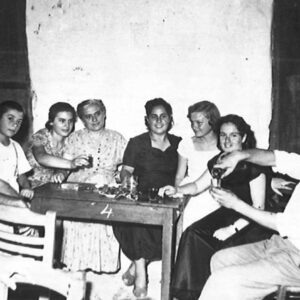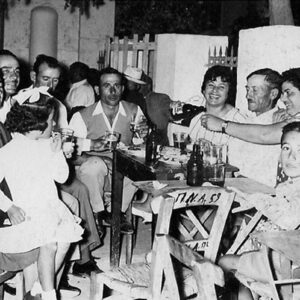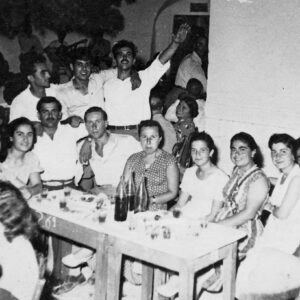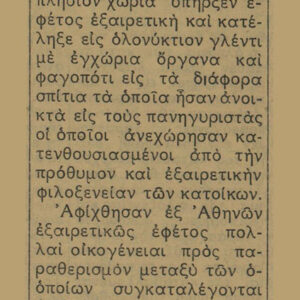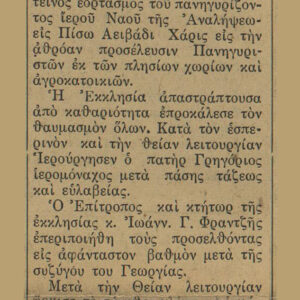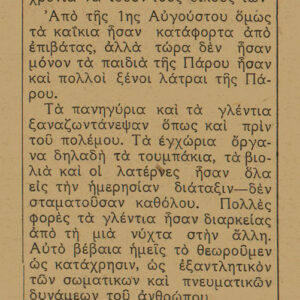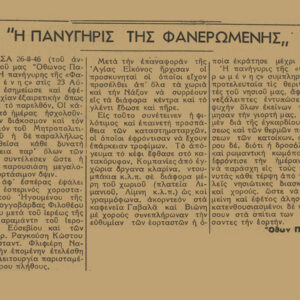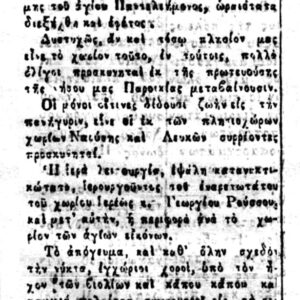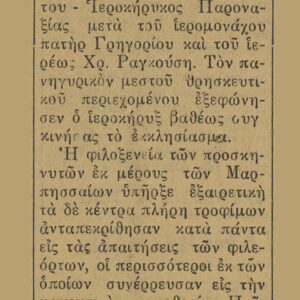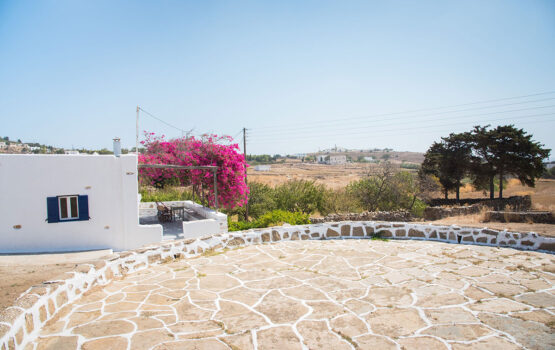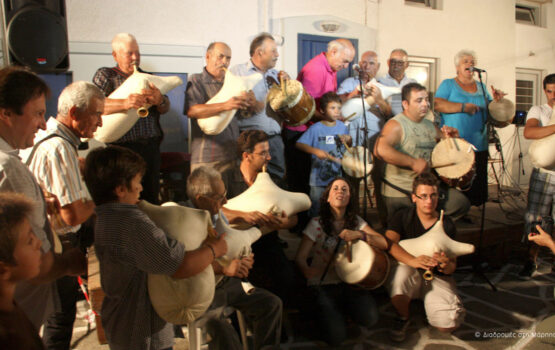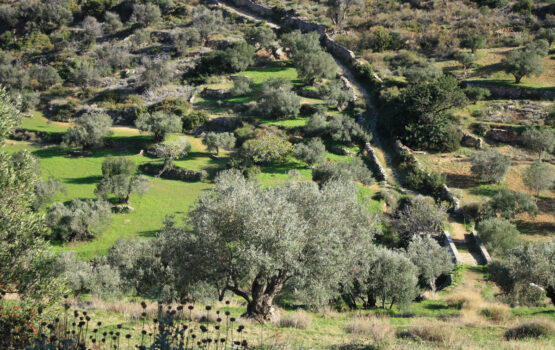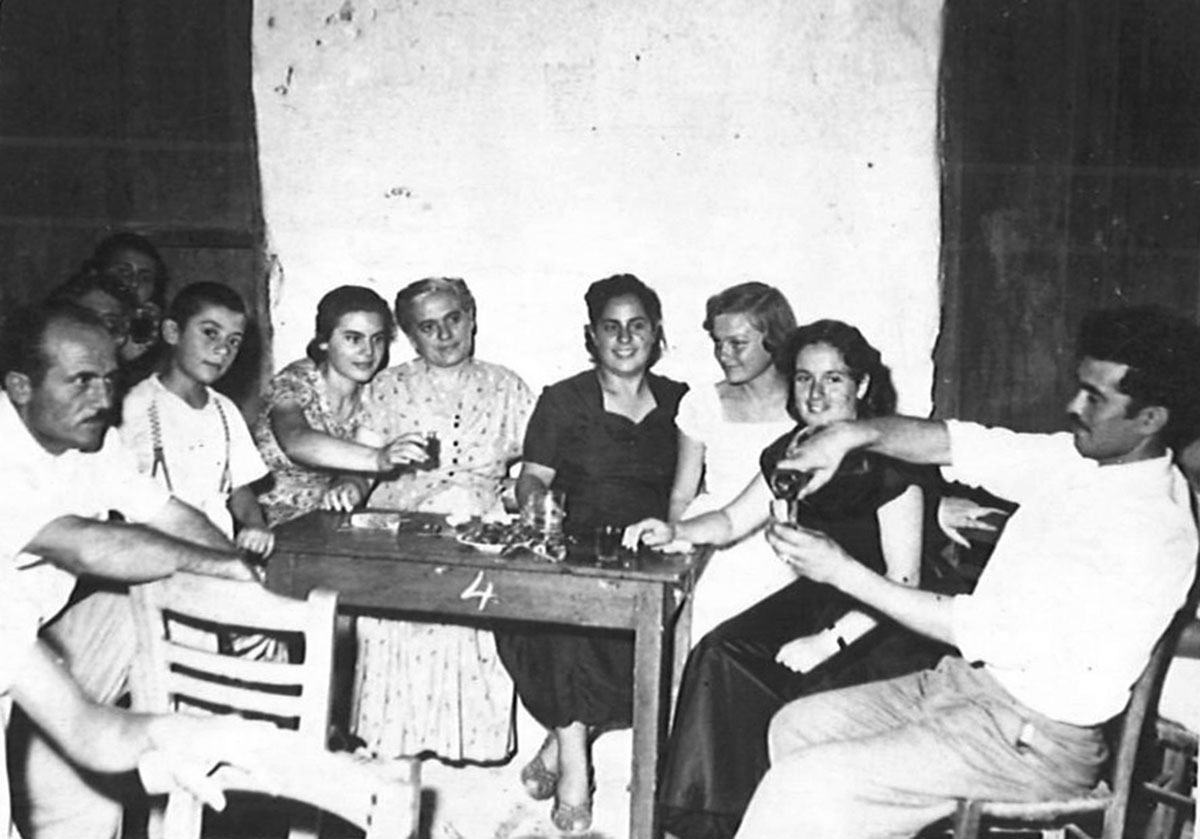
The traditional festivals (“Panigyria”) of Paros
“Give the dance a go,
the night is young”
Zacharias Stellas, PAROS: unshapely paintings, MYTHS, TALES, and other folklore and linguistic elements
The tradition of “Panigyria” (traditional festivals) is interconnected with the numerous religious holidays and Saints’ “namedays” throughout the year. Each village has its own feast, which is associated with its parish church and the respective Saint’s nameday.
In the Cyclades, the small churches inside and outside settlements also hold a feast to celebrate their respective Saint, organised by the family that is responsible for each church’s maintenance. The family in charge of each church makes timely preparations for the Saint’s nameday. They take care of cleanliness, whitewash the church, and polish the candelabra. On the eve of the festival, they decorate the Cross and the icon of the honoured Saint with flowers from the gardens. They also decorate the entrance and courtyard and scatter aromatic herbs (myrtle, oregano, thyme and sage) on the street leading up to the church. On the day of the feast, after the service, treats are offered to those present in the courtyard of the church.
The residents actively participate in the big festivals, which constitute a great opportunity for socialisation. The most important festivals of the island are the following:
- The festival of Agios Ioannis Thelogos, on May 8 in Drios
- The festival of Analipsi, in Piso Livadi
- The festival of Agia Triada, in Lefkes
- The festival of Agios Ioannis Prodromos, on June 24 in Prodromos
- The festival of Agios Panteleimon, on July 27 in Kostos
- The festival of Metamorphosi tou Sotiros (“of the Christ”), on August 6 in Marpissa
- The festival of Koimisi tis Theotokou, on the 15th of August in Parikia
- The festival of Panagia Faneromeni, on August 23 in Naoussa
- The festival of Agios Fanourios, on August 27 in Ambelas
- The festival of the birth of the Theotokos, on September 8 in Pera Panagia in Marmara
Traditional festivals constitute an occasion for the inhabitants of each village, but also of the whole island, to meet, socialise, and participate in the feast. The celebration takes place after the evening service, or, occasionally, during the day. Long ago, groups of friends would go, either on foot or by mule, to the village where the festival would take place, and would often spend the night with friends or relatives and go home on the next day. The older generation remembers the festivals that took place during the day, before electricity. When electricity came along, festivals began to take place mainly in the evening.
In the newspaper “Aegeon” (Aegean), issue No. 263, 1907, the correspondent in Paros reports on the festival of Agios Panteleimon in Kostos: During the afternoon and throughout the night, there were traditional dances accompanied by the violin, now and then a little polka dance, with the young pilgrims gathering in the hospitable homes of the people of Kostos.
In the newspaper “Kykladika Nea” (Cycladic News), issue No. 20, 1935, we read that: with exceptional magnificence and a large participation of pilgrims from all villages, the festival of Agios Ioannis was celebrated in the hospitable and friendly village of Dragoulas. After the procession, the visitors spent the night in the villagers’ hospitable homes, where there was plenty of red mullet and wheat bread.
In the newspaper “Foni tis Parou” (Voice of Paros), issue No. 1, 1945, we can read a report from Lefkes: The traditional festivals were revived as before the war. The traditional instruments, namely the ntoumbaki, the violin, and the barrel organ were all on the agenda; the orchestra kept playing throughout the festival. Often, the festivities lasted consecutive nights. Of course, we consider this to be an abuse, an exhaustion of the physical and spiritual forces of man. However, as we hear, the wine was so exquisite and overflowing, and there was so much variety and abundance of food and “meze” appetisers (poultry, eggs, piglets, fish, cheese, and fruit) that the sons of Bacchus, having endured such deprivation and famine, should not be so harshly judged.
Nowadays, in Paros, the festivals are organised by the community, and take place in the village square; nevertheless, the festivities of the past in the village’s taverns have left their mark. Margarita Malamateniou remembers the taverns of Marpissa: there was the tavern of Dimas and Giannakakias in Pefko, and, on the street near the Lower Mills, the summer tavern of “Miltiadis”, next to an orchard, where the tables were set up. Also, there was a tavern in Agios Nikolas, in the centre of the village, and one in the current parking lot near the old cistern (Upper Mills). Circa 1952-55 there were eight taverns in Marpissa.
“The violins”…
The festivities were accompanied by those who knew how to play a musical instrument in each village, but there were also bands that toured the entire island.
During the period 1920-1970, compared to the violin, the clarinet was very popular as a basic instrument in the music orchestras of the island, probably due to the skill of specific musicians. Indicatively, we mention the following musicians:
- “Niotis”: thanks to him, the clarinet became popular on the island
- Manolis Ragousis from Lefkes, clarinet
- Tassos Ragousis from Lefkes, violin and santoor
- Nikolas Vintzilaios from Aspro Chorio, clarinet
- Nikos Bonis from Piso Livadi, accordion
- Antonis Tsigonias (Aggelis) from Marpissa, clarinet
- Thanasis Tsigonias (Aggelis) from Marpissa, lute
- Dimitris Tsigonias (Aggelis) from Marpissa, santoor
- Manolis Prasinos in Naoussa, violin and santoor
- Dimosthenis Skiadas from Naoussa, clarinet
- Michalis Varbaxidis or “Samiotis”, guitar and accordion
- Nikos Tsigonias and Giannis Tsigonias from Marpissa, tsambouna and toumpaki
In recent years, and especially after 1990, the Community and the Municipality is in charge of the orchestra and the catering of the big festivals that nowadays take place in village squares.
“Paraggelia” (Request, or dance with priority number)
The dancing during the festivals followed a specific procedure or ritual: The musicians were paid by the guests; the order in which the latter danced was determined by the little pieces of paper with specific requests that they had previously given to the instrument players.
Whoever dances, mostly moves in circles. These dance moves were also called “fyllades” or “flades” from the “fyllada” plant (oleander): In order to cut its branches, one has to go all around it and use skill and strength…
Zacharias Stellas, PAROS: unshapely paintings, MYTHS, TALES, and other folklore and linguistic elements
At the Panigyri feast... circles, turns, and twirls!
“Kanarini mou glyko”, “Maoukas”, “Ego eimai enos psara paidi”, “Sto boi sou kyra mou”, “Agio Theodoritissa”, and “I klossou” were among the most popular songs in festivals. Kalamatianos, syrtos, and ballos were the traditional dances; in particular, “tsambounistos ballos” (ballos accompanied by the tsambouna) enlivened the guests, and offered them a chance to show off skilful dancing moves. According to testimonies, there were several talented dancers in Marpissa: Flora Anousaki, Kostakis Aliprantis, Nikolas Tsigonias (Boutsis), Manolis Asonitis (Psaropoulas), Manolis Tsigonias (Kounados), and Angelos Tsigonias. In the past, European dances (tango, English fox trot, waltz, etc.) were included in the repertoire of festivals, while the men also danced the “Voulgarikos” (Bulgarian), which was a local variation of the “chasapiko” dance, accompanied by the tsambouna.
A characteristic element of the songs was improvisation. The improvised couplets of Stefanos Frantzis (Kalkounas) and Antonis Tsigonias -mainly according to the custom of “Klidonas”- left their mark, as did the sisters Giakoumina Triantafyllou and Paraskevi Tzioti in the 1920s.
Hot-blooded misunderstandings and arguments were not uncommon during feasts:
I remember I was thirty-five years old back in 1975, at the festival at Anousakis, when a girl asked me to dance with her. Then, someone came up to me and told me not to dance and to go away. I almost got into a nasty fight… it took ten people to hold me back…
Often, during feasts, there were fights over a girl. Circa 1957, there was a big fight at a feast held at Nikitas Asonitis’s shop, which was both a cafeteria and a barber shop. An engaged couple was dancing; the woman was very beautiful, she was from Parikia… and one of the villagers told the man to sit down and that he was going to dance with her. A fight broke out, tables fell, bottles broke… (Nikolas Tsigonias “Boutsis”)
Festivals are an important part of our tradition and identity. They may change as a dynamic element of our culture, but they continue to offer to many of us an opportunity to revisit our homeland and get to know our roots.
Sources
Correspondent (1935) “Correspondence: From Paros, Kykladika Nea, issue No. 20, p. 4
Correspondent (1945) “Correspondence: Lefkes”, I Foni tis Parou, issue No. 1, p. 2
Archives of the Association “Routes in Marpissa”.
ESM (1907) “Correspondence: PAROS, 1 August 1907”, Aegeon, issue No. 263, p. 3
Ragoussi – Kondogiorgou, K. (2004) Paros and Antiparos: the altar of my soul. Paros: Anthemion.
Stellas, Z. (2005) ΠάΡΟΣ, ζουγραφιές ατσούμπαλες, ΜύΘΙΑ ΠΑΡΑΜύΘΙΑ. (Paros, unshapely paintings: Tales, Fairytales) Athens: n.p.
Tsantanis, N. (2011) The tsambouna and the tsambouna player in Paros and Syros, Undergraduate Thesis, Technological Educational Institution (TEI) of Epirus, Arta.
Special thanks to Katina Alipranti-Anastasiadou, Nikitas Aliprantis, Nikolas Tsigonias (Boutsis), Sofia Kefala, Margarita Malamateniou, Kaiti Pastra, Fanouris Petropoulos, Maria Tsantouli, Betty Tsantouli – Stella for their valuable information assistance.

